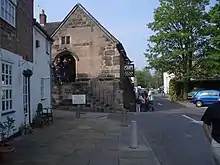Scheduled monuments in Derby
This is a list of Scheduled Monuments in the City of Derby unitary authority in the English county of Derbyshire.
In the United Kingdom, a scheduled monument is a "nationally important" archaeological site or historic building that has been given protection against unauthorised change by being placed on a list (or "schedule") by the Secretary of State for Culture, Media and Sport; English Heritage takes the leading role in identifying such sites.[1] Scheduled monuments are defined in the Ancient Monuments and Archaeological Areas Act 1979 and the National Heritage Act 1983. They are also referred to as scheduled ancient monuments. There are about 20,000 Scheduled Monument entries on the list, which is maintained by English Heritage; more than one site can be included in a single entry.
While a scheduled monument can also be recognised as a listed building, English Heritage considers listed building status as a better way of protecting buildings than scheduled monument status. If a monument is considered by English Heritage to "no longer merit scheduling" it can be descheduled.[2]
Derbyshire has over 500 Scheduled Monuments including many stone cairns, stone circles, barrow burial mounds, lead mining relics, ancient settlements, and over 20 bridges.[3]
| Image | Name and reference | Feature | Location | Notes |
|---|---|---|---|---|
| Anglo-Scandinavian high cross shaft in the churchyard of St Werburgh's Church[4] | Cross | Spondon | The remaining limestone shaft of the high cross dates back 9th century. The original cross head is missing. | |
 The Abbey Pub |
Darley Abbey[5] | Church | Darley Abbey | Remains of Augustinian abbey, which was founded by Robert de Ferrers, 2nd Earl of Derby, in c.1146 and dissolved in 1538. The only building still standing was a hall house, and it is now The Abbey pub.[6] |
| Derby Racecourse Roman vicus and cemetery[7] | Settlement | Derby | Roman civilian settlement on the Roman road between the Roman fort at Little Chester (Derventio) and the River Trent at Sawley. | |
| Littlechester Roman site[8] | Settlement | Derby | The site of Derventio Coritanorum Roman fort. Much of the original Roman site is now beneath modern housing development and gardens.[9] | |
| Roman bath house at Parker's Piece[10] | Building | Derby | Buried remains of the bath house were discovered in 1924, close to the Roman fort of Derventio. | |
| Rykneld Street Roman road and remains of Bronze Age cemetery[11] | Road | Littleover | Short section of the Roman road between Wall at Litchfield and the nearby fort at Derventio. | |
| St Mary's Bridge[12] | Bridge | Derby | St Mary's Bridge was built in 1788-93 by Thomas Harrison. A medieval bridge which was demolished to make way for it. It has three arches and spans the River Derwent.[13] |
See also
- Scheduled monuments in Derbyshire
- Scheduled monuments in Amber Valley
- Scheduled monuments in Bolsover
- Scheduled monuments in Chesterfield
- Scheduled monuments in Derbyshire Dales
- Scheduled monuments in the Borough of Erewash
- Scheduled monuments in High Peak
- Scheduled monuments in North East Derbyshire
- Scheduled monuments in South Derbyshire
- Grade I listed buildings in Derbyshire
- Grade II* listed buildings in Derby
References
- "The Schedule of Monuments". PastScape. Retrieved 4 February 2009.
- "Archaeological activities undertaken by English Heritage". English Heritage. Archived from the original on 26 November 2006. Retrieved 15 February 2009.
- Historic England. "Darley Abbey (remains of) (1007050)". National Heritage List for England. Retrieved 27 November 2020.
- Historic England. "Anglo-Scandinavian high cross shaft in the churchyard of St Werburgh's Church, Spondon (1008608)". National Heritage List for England. Retrieved 27 November 2020.
- Historic England. "Darley Abbey (remains of) (1007050)". National Heritage List for England. Retrieved 27 November 2020.
- "Heritage Gateway - Results". www.heritagegateway.org.uk. Retrieved 28 November 2020.
- Historic England. "Derby Racecourse Roman vicus and cemetery (1012582)". National Heritage List for England. Retrieved 27 November 2020.
- Historic England. "Littlechester Roman site (1007043)". National Heritage List for England. Retrieved 27 November 2020.
- "Heritage Gateway - Results". www.heritagegateway.org.uk. Retrieved 28 November 2020.
- Historic England. "Roman bath house at Parker's Piece (1007049)". National Heritage List for England. Retrieved 27 November 2020.
- Historic England. "Section of Rykneld Street Roman road and remains of Bronze Age cemetery at Littleover (1021321)". National Heritage List for England. Retrieved 27 November 2020.
- Historic England. "St Mary's Bridge (1004597)". National Heritage List for England. Retrieved 27 November 2020.
- "Heritage Gateway - Results". www.heritagegateway.org.uk. Retrieved 28 November 2020.